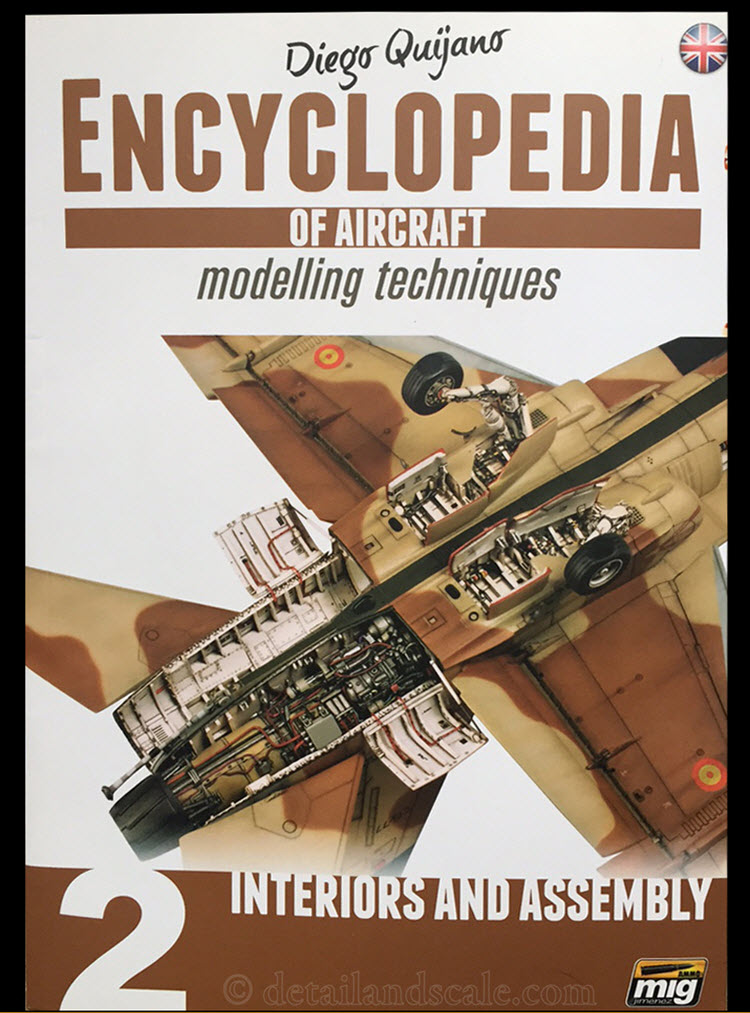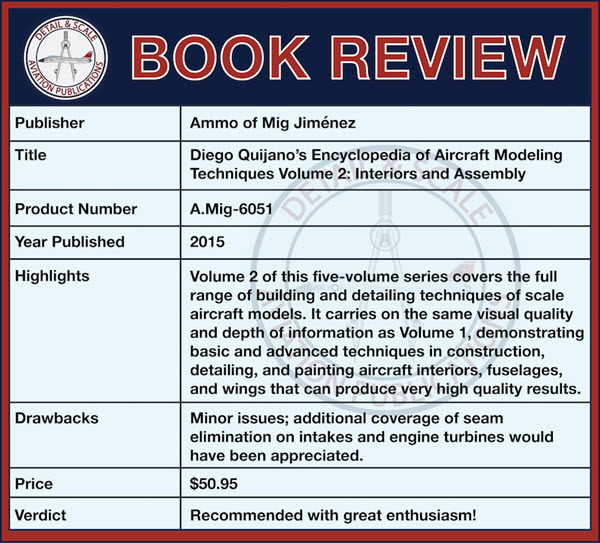Diego Quijano’s Encyclopedia of Aircraft Modeling Techniques Volume 2: Interiors and Assembly
Published by Ammo of Mig Jiménez, 2015



In this review, Detail & Scale takes a look at the second installment of Diego Quijano’s modeling techniques encyclopedia. The second volume in the series, Diego Quijano’s Encyclopedia of Aircraft Modeling Techniques 1: Interiors and Assembly, takes readers through the process of assembling, detailing, painting, and detail painting wheel wells, landing gear, interior airframe details, jet engine exhaust nozzles, piston engines, and much more.
In essence, it’s everything one needs to take care of before taking their model to the paint shop.
Volume 2, as Volume 1, maintains the same level of production quality and gets an unequivocal A+ in this department. This 160 page-long volume is printed in Spain, and comes in full color on high quality paper. The images, once again, are technically flawless and represent some of the best scale model photography out there. And, just as with Volume 1, the text is thoughtfully written to speak to novices and advanced modelers alike. Additionally, Quijano’s work volumein this is supplemented by that of several other master scale modelers.
Volume 2: Interiors and Assembly is 160 pages long and contains several hundred photos. photos. It is organized into two parts, sequentially continuing on with the numbered sections from Volume 1. Part 3 covers interiors (landing gear, scratchbuilt interiors, piston engines, and jet engines). Part 4 focuses on exterior assembly (fuselage, wings, detailing, and masking).
Conceptually, I see Part 3 as working modelers through the construction, painting, and detailing of pretty much everything aside from the cockpit (covered in Volume 1) that needs to get done before closing up the fuselage and wings. Starting with, landing gear, Section 3.1 drives home some very important points and techniques. Much of the gear and gear well section chronicles the stepwise work on a F/A-18, MiG-21, Me 262, and an F-16. Yet, the techniques shown here, from the detail painting, plumbing, and application of washes can be applied to virtually any scale model.
To me, a few take-aways from Section 3 involve just how a careful and precisely applied dark wash and even use of India ink can bring out details in gear wells. The use of watercolor pencils and Gundam and Copic Modeler fine tipped markers are shown to produce very fine and impressively realistic chipping effects on gear door interiors. Many readers (including myself) are introduced to Plus Model’s lead wire products (you can find them at plusmodel.cz, and I am not aware of any U.S.- based distributor). These wires come in a nearly every imaginable diameter, and look like they might be one of the best commercially available products to do brake and electrical lines on landing gear. Great techniques are also shown in how make mounting brackets for these lines, and for the prep and all-important polishing of cast metal landing gear before painting.
Section 3.1.3 covers tires. The last thing I thought I would be giving accolades to in this review were tires – but Quijano takes readers through the tire prep, detailing, washes, and weathering of tires. For me, tires are sometimes a rushed if not slightly neglected part of a build. Here, tires is really given justice, as something like six different simple and advanced tire painting and weathering techniques are demonstrated. The results are surprisingly impressive.
Section 3.2 walked through how one can use fairly straightforward techniques to scratchbuilt interior details, from panel interiors to avionics bays. It interesting to watch how Quijano goes from fairly simple construction techniques to exquisite final products, such as in the F/A-18 and F-104 projects shown on pages 49-51. To me, this underscores if even an average modeler is able to nail the basics and can execute a careful detailing wash, some very impressive results can emerge. Seeing this work should simultaneously blow the reader away, but also make them realize that the basic techniques underlying great results are “something I can do, too.”
Section 3.3 focuses on piston engine (radial, rotary, and inline) construction, painting, detailing, and weathering. Included are well-honed methods to fashion and attach pushrods, spark plug wires, and other details. Section 3.3.2 is a contribution by J.M. Villalba, who takes the reader through the construction, detailing, and painting of inline engines (called V-engines, which is a bit of an awkward translation). Other examples in this section are a fairly stunning P-40 and a Whitley Mk. V with exposed engines by Alex Kontiveis.
Moving to jet motors in Section 3.4, Quijano returns to first spend a short time on intakes. Most of this section involves the best exposition I’ve ever seen on techniques for painting jet engine exhaust nozzles. Examples include building and painting Voyager Model’s photoetch metal 1:48 F110 engine nozzle (which itself is a stunning aftermarket product). He demonstrates a particularly effective way of progressive toning of the metal exhaust petals using transparent colors along with detail painting and weathering of the interior of the exhaust. Also described are advanced nozzle painting techniques using kit parts from an F/A-18 using a variety of washes, streaking, and airbrushing effects. Another demonstration by Mig Jimenez shows the effects that one can achieve with metal polishing powders as demonstrated on the back ends of an English Electric Lighting, a MiG-25, and a Sukhoi T-50. The final parts of Section 3.4 demonstrates painting techniques of an entire jet engine (they’re sure not monochromatic!), detailing a jet engine, and scratchbuilding a jet engine.
While a modeler may give their kit extraordinary detail, makes or breaks the quality of a build are the fundamentals of construction. Having been a judge at model shows for some 18 years including IPMS Nationals, I can say (as per the rule book) the presence of construction flaws (i.e., seams, gaps, bad alignment) is what eliminates otherwise great work from contention. Section 4, Exterior Assembly, provides a comprehensive guide to basic construction of fuselages and wings. This includes comparative demonstrations of various kinds of adhesives, multiple seam filling techniques, sanding and polishing of seams, and how to seamlessly integrate ill-fitting parts.
In all that work, panel lines and screw/rivet detail may be lost, filled in, sanded down or otherwise eliminated. Restorative techniques involving panel line scribing, use of pounce (or rivet) wheels, and detailing with awls and hypodermic needles are demonstrated. I think one of my favorite things in this book is section 4.1.7, which demonstrates two of the coolest techniques I’ve ever seen on how to achieve a stressed skin effect. Multiple approaches to doing navigation lights are covered, as well as how to drop control surfaces which is demonstrated on biplanes and jets.
Volume 2 closes with getting your model ready for the paint shop – masking off all that great interior detail. Methods involving standard uses of tape are demonstrated, along with plugging interior spaces such as jet intakes with thin foam blocks or canopy interior seams with blue tack (silly puddy) that allows a canopy to be painted in place without overspray reaching in.

There are very few shortcomings to Volume 2, but three minor critiques come to mind. I would have appreciated more time spent on jet engine intakes. Readers no doubt would like to see more on how Quijano tackles kit-supplied intakes and his techniques for the elimination of intake seams. Similarly, seam elimination in the back end of a injection-molded kit’s jet engine turbine could have also been discussed more, which often even harder to eliminate than seams in an intake. Section 4.3 contains great information on detailing your build, from the preparation and use of photoetch metal and resin parts to the resin casting. The placement of this section just seems a little out of order, and for me, would have worked a little better if placed a little earlier in the book.

Volume 2 of Diego Quijano’s Encyclopedia of Aircraft Modeling Techniques is just as impressive and valuable as Volume 1. It’s filled excellent techniques and a clear, well-written narrative. It’s a little more pricey than the first volume as it is longer, but these books are a high-value, high-return investment for scale model aircraft builders .For me, these volumes really stimulate my sense of creativity in scale modeling. It again reinforces how an emphasis on good basic techniques can go a long, long way. By the end of Volume 2, the reader is now ready to begin painting. I can’t wait to see what’s in store for Volume 3, especially since Quijano and colleagues are world renown for their extraordinary paint jobs and finishes.
Many thanks are owed to Mig Jiménez and Iain Hamilton for the review copy of Volume 2. Mil gracias y muchos saludos!
Volume 2 of the Encyclopedia of Aircraft Modeling Techniques is recommended without reservation. You can get a copy at the following sources:
Haagen Klaus
Scale Modeling News & Reviews Editor
Detail & Scale


